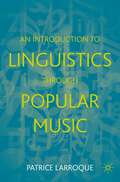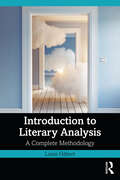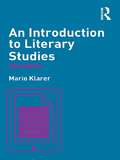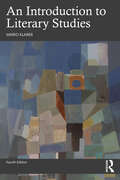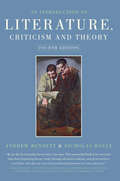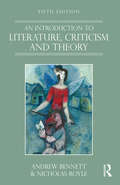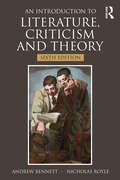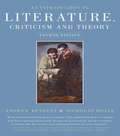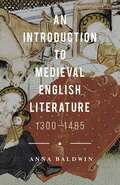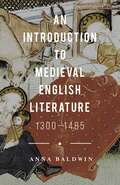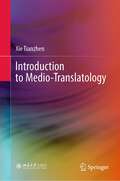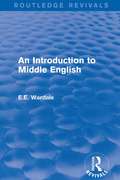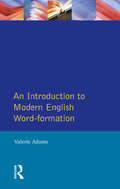- Table View
- List View
An Introduction to Linguistics
by Stuart C PooleThis lively and wide-ranging textbook provides an invaluable guide to the very nature of language. By covering all major aspects of linguistics - with chapters on semantics (the study of meaning), phonology (the sound systems of languages) and morphology (the structure of words), as well as syntax and social variation - it gives a thorough grounding in the fundamental concepts of language and a practical analysis of its use.Concise summaries of the areas covered, a variety of texts and topic-related exercises, as well as a helpful glossary, provide further aids to study and revision.
An Introduction to Linguistics through Popular Music
by Patrice LarroqueThis textbook introduces the field of linguistics, demonstrating syntactic categories, morphological structures, phonological/metric structures, syllable structures, and varieties of English in an accessible way by using portions of song lyrics from popular music. The varieties of English covered include Received Pronunciation (RP) and General American, as well as some features of Australian English, southern US varieties, and Scottish English. Drawing on shared characteristics between language and music, including metrical structure, the author suggests a different approach to linguistic analysis and the description of spoken language. The book introduces both students and instructors to a novel and engaging method of description, and provides a fresh vocabulary with which to start thinking about language. It demonstrates complex topics by using music as a fun and familiar starting point, and will be an ideal resource for introductory linguistics courses worldwide.
Introduction to Literary Analysis: A Complete Methodology
by Louis HébertThis book provides a complete guide to analyzing literary works, from an introduction of basic principles to the finer details. Separated into three sections, the book covers: • Principles—this looks at what literary analysis is, its three main components, and the various possible objects of analysis • Main components—introduces nearly 30 aspects of text analysis, such as style, themes, social aspects, and context, and then goes on to introduce nearly 50 approaches, such as literary history, ecocriticism, narratology, and sociology • The process of analysis—details the general structure of the analytical text, the structure of a pedagogical essay, the analysis of a theoretical element, possible “plans” for the analytical text, methods of argumentation, statements of opinion, hypotheses, the structure of paragraphs, and the use of citations. This book is a synthesis of established scholarship with new, original insights, making it an ideal introduction to the study of literature as well as a valuable companion throughout further study.
Introduction to Literary Analysis: A Complete Methodology
by Louis HébertThis book provides a complete guide to analyzing literary works, from an introduction of basic principles to the finer details. Separated into three sections, the book covers: • Principles—this looks at what literary analysis is, its three main components, and the various possible objects of analysis • Main components—introduces nearly 30 aspects of text analysis, such as style, themes, social aspects, and context, and then goes on to introduce nearly 50 approaches, such as literary history, ecocriticism, narratology, and sociology • The process of analysis—details the general structure of the analytical text, the structure of a pedagogical essay, the analysis of a theoretical element, possible “plans” for the analytical text, methods of argumentation, statements of opinion, hypotheses, the structure of paragraphs, and the use of citations. This book is a synthesis of established scholarship with new, original insights, making it an ideal introduction to the study of literature as well as a valuable companion throughout further study.
An Introduction to Literary Studies
by Mario KlarerIn this classic beginner's guide to English literature, Mario Klarer offers a concise and accessible discussion of central issues in the study of literary texts, looking at: definitions of key terms such as literature and text the genres of fiction, poetry, drama, and film periods and classifications of literature theoretical approaches to texts the use of secondary resources guidelines for writing research essays The new and expanded edition is fully updated to include: a wider range of textual examples from world literature additional references to contemporary cinema, a section on comparative literature an extended survey of literary periods and genres recent changes in MLA guidelines information on state-of-the-art citation management software the use and abuse of online resources. The book also features suggestions for further reading as well as an extensive glossary of key terms.
An Introduction to Literary Studies
by Mario KlarerIn this classic beginner's guide to English literature, Mario Klarer offers a concise and accessible discussion of central issues in the study of literary texts, looking at: definitions of key terms such as literature and text the genres of fiction, poetry, drama, and film periods and classifications of literature theoretical approaches to texts the use of secondary resources guidelines for writing research essays The new and expanded edition is fully updated to include: a wider range of textual examples from world literature additional references to contemporary cinema, a section on comparative literature an extended survey of literary periods and genres recent changes in MLA guidelines information on state-of-the-art citation management software the use and abuse of online resources. The book also features suggestions for further reading as well as an extensive glossary of key terms.
An Introduction to Literary Studies
by Mario KlarerThe fourth edition of this classic beginner’s guide to literary studies has been fully updated throughout. Mario Klarer offers a concise and accessible discussion of central issues in English and world literature as well as film and television series. Starting with the basics of what constitutes a literary text, the book moves through an analysis of major genres, important periods, and key theoretical approaches to literature and film. It also looks at the practicalities of finding and referencing secondary sources when writing a research paper. The expanded new edition has been updated to include: a wider range of examples from world literature, cinema, and television series additional references to contemporary streaming formats updated chapters on postcolonial theory, cultural studies, gender theory, feminism, and queer theory new sections on digital humanities, ecocriticism, literary translations, and paratexts extended explanations of traditional genres, e.g., the epic, drama, and poetry a completely revised chapter on the most recent MLA guidelines with rules for citing new media formats The detailed glossary ensures that the book is accessible to readers of any level, making this an ideal self-study guide or a course book for Introduction to Literature classes.
An Introduction to Literary Studies
by Mario KlarerThe fourth edition of this classic beginner’s guide to literary studies has been fully updated throughout. Mario Klarer offers a concise and accessible discussion of central issues in English and world literature as well as film and television series. Starting with the basics of what constitutes a literary text, the book moves through an analysis of major genres, important periods, and key theoretical approaches to literature and film. It also looks at the practicalities of finding and referencing secondary sources when writing a research paper. The expanded new edition has been updated to include: a wider range of examples from world literature, cinema, and television series additional references to contemporary streaming formats updated chapters on postcolonial theory, cultural studies, gender theory, feminism, and queer theory new sections on digital humanities, ecocriticism, literary translations, and paratexts extended explanations of traditional genres, e.g., the epic, drama, and poetry a completely revised chapter on the most recent MLA guidelines with rules for citing new media formats The detailed glossary ensures that the book is accessible to readers of any level, making this an ideal self-study guide or a course book for Introduction to Literature classes.
An Introduction to Literature, Criticism and Theory
by Andrew Bennett Nicholas RoyleLively, original and highly readable, An Introduction to Literature, Criticism and Theory is the essential guide to literary studies. Starting at 'The Beginning' and concluding with 'The End', chapters range from the familiar, such as 'Character', 'Narrative' and 'The Author', to the more unusual, such as 'Secrets', 'Pleasure' and 'Ghosts'. Now in its fifth edition, Bennett and Royle's classic textbook successfully illuminates complex ideas by engaging directly with literary works, so that a reading of Jane Eyreopens up ways of thinking about racial difference, for example, while Chaucer, Raymond Chandler and Monty Python are all invoked in a discussion of literature and laughter. The fifth edition has been revised throughout and includes four new chapters - 'Feelings', 'Wounds', 'Body' and 'Love' - to incorporate exciting recent developments in literary studies. In addition to further reading sections at the end of each chapter, the book contains a comprehensive bibliography and a glossary of key literary terms. A breath of fresh air in a field that can often seem dry and dauntingly theoretical, this book will open the reader's eyes to the exhilarating possibilities of reading and studying literature.
An Introduction to Literature, Criticism and Theory
by Andrew Bennett Nicholas RoyleLively, original and highly readable, An Introduction to Literature, Criticism and Theory is the essential guide to literary studies. Starting at ‘The Beginning’ and concluding with ‘The End’, chapters range from the familiar, such as ‘Character’, ‘Narrative’ and ‘The Author’, to the more unusual, such as ‘Secrets’, ‘Pleasure’ and ‘Ghosts’. Now in its fifth edition, Bennett and Royle’s classic textbook successfully illuminates complex ideas by engaging directly with literary works, so that a reading of Jane Eyre opens up ways of thinking about racial difference, for example, while Chaucer, Raymond Chandler and Monty Python are all invoked in a discussion of literature and laughter. The fifth edition has been revised throughout and includes four new chapters – ‘Feelings’, ‘Wounds’, ‘Body’ and ‘Love’ – to incorporate exciting recent developments in literary studies. In addition to further reading sections at the end of each chapter, the book contains a comprehensive bibliography and a glossary of key literary terms. A breath of fresh air in a field that can often seem dry and dauntingly theoretical, this book will open the reader’s eyes to the exhilarating possibilities of reading and studying literature.
An Introduction to Literature, Criticism and Theory
by Andrew Bennett Nicholas RoyleLively, original and highly readable, An Introduction to Literature, Criticism and Theory is the essential guide to literary studies. Starting at ‘The Beginning’ and concluding with ‘The End’, chapters range from the familiar, such as ‘Character’, ‘Narrative’ and ‘The Author’, to the more unusual, such as ‘Secrets’, ‘Pleasure’ and ‘Ghosts’. Now in its fifth edition, Bennett and Royle’s classic textbook successfully illuminates complex ideas by engaging directly with literary works, so that a reading of Jane Eyre opens up ways of thinking about racial difference, for example, while Chaucer, Raymond Chandler and Monty Python are all invoked in a discussion of literature and laughter. The fifth edition has been revised throughout and includes four new chapters – ‘Feelings’, ‘Wounds’, ‘Body’ and ‘Love’ – to incorporate exciting recent developments in literary studies. In addition to further reading sections at the end of each chapter, the book contains a comprehensive bibliography and a glossary of key literary terms. A breath of fresh air in a field that can often seem dry and dauntingly theoretical, this book will open the reader’s eyes to the exhilarating possibilities of reading and studying literature.
An Introduction to Literature, Criticism and Theory
by Andrew Bennett Nicholas RoyleLively, original and highly readable, An Introduction to Literature, Criticism and Theory is the essential guide to literary studies. Starting at ‘The Beginning’ and concluding with ‘The End’, chapters range from the familiar, such as ‘Character’, ‘Narrative’ and ‘The Author’, to the more unusual, such as ‘Secrets’, ‘Pleasure’ and ‘Ghosts’. Now in its sixth edition, Bennett and Royle’s classic textbook successfully illuminates complex ideas by engaging directly with literary works, so that a reading of Jane Eyre opens up ways of thinking about racial difference, for example, while Chaucer, Monty Python and Hilary Mantel are all invoked in a discussion of literature and laughter. The sixth edition has been revised and updated throughout. In addition, four new chapters – ‘Literature’, ‘Loss’, ‘Human’ and ‘Migrant’ – engage with exciting recent developments in literary studies. As well as fully up-to-date further reading sections at the end of each chapter, the book contains a comprehensive bibliography and an invaluable glossary of key literary terms. A breath of fresh air in a field that can often seem dry and dauntingly theoretical, this book will open the reader’s eyes to the exhilarating possibilities of reading and studying literature.
An Introduction to Literature, Criticism and Theory
by Andrew Bennett Nicholas RoyleLively, original and highly readable, An Introduction to Literature, Criticism and Theory is the essential guide to literary studies. Starting at ‘The Beginning’ and concluding with ‘The End’, chapters range from the familiar, such as ‘Character’, ‘Narrative’ and ‘The Author’, to the more unusual, such as ‘Secrets’, ‘Pleasure’ and ‘Ghosts’. Now in its sixth edition, Bennett and Royle’s classic textbook successfully illuminates complex ideas by engaging directly with literary works, so that a reading of Jane Eyre opens up ways of thinking about racial difference, for example, while Chaucer, Monty Python and Hilary Mantel are all invoked in a discussion of literature and laughter. The sixth edition has been revised and updated throughout. In addition, four new chapters – ‘Literature’, ‘Loss’, ‘Human’ and ‘Migrant’ – engage with exciting recent developments in literary studies. As well as fully up-to-date further reading sections at the end of each chapter, the book contains a comprehensive bibliography and an invaluable glossary of key literary terms. A breath of fresh air in a field that can often seem dry and dauntingly theoretical, this book will open the reader’s eyes to the exhilarating possibilities of reading and studying literature.
An Introduction To Literature, Criticism And Theory (PDF)
by Andrew Bennett Nicholas RoyleFresh, original and compelling, "An Introduction to Literature, Criticism and Theory "is the essential guide to literary studies. Starting at the beginning and concluding with the end, the book covers topics that range from the familiar (character, narrative, the author) to the more unusual (secrets, pleasure, ghosts). Eschewing abstract "isms," Bennett and Royle successfully illuminate complex ideas by engaging directly with literary works so that a reading of "Jane Eyre" opens up ways of thinking about racial difference, whilst Chaucer, Raymond Chandler and Monty Python are all invoked in a discussion of literary laughter. Each chapter ends with a narrative guide to further reading and the book also includes a glossary and bibliography. The fourth edition has been revised to incorporate two timely new chapters on animals and the environment. A breath of fresh air in a field that can often seem dry and dauntingly theoretical, this book will open the reader s eyes to the exhilarating possibilities of both reading and studying literature. "
An Introduction to Mathematical Logic and Type Theory: To Truth Through Proof (Applied Logic Series #27)
by Peter B. AndrewsIn case you are considering to adopt this book for courses with over 50 students, please contact ties.nijssen@springer.com for more information. This introduction to mathematical logic starts with propositional calculus and first-order logic. Topics covered include syntax, semantics, soundness, completeness, independence, normal forms, vertical paths through negation normal formulas, compactness, Smullyan's Unifying Principle, natural deduction, cut-elimination, semantic tableaux, Skolemization, Herbrand's Theorem, unification, duality, interpolation, and definability. The last three chapters of the book provide an introduction to type theory (higher-order logic). It is shown how various mathematical concepts can be formalized in this very expressive formal language. This expressive notation facilitates proofs of the classical incompleteness and undecidability theorems which are very elegant and easy to understand. The discussion of semantics makes clear the important distinction between standard and nonstandard models which is so important in understanding puzzling phenomena such as the incompleteness theorems and Skolem's Paradox about countable models of set theory.Some of the numerous exercises require giving formal proofs. A computer program called ETPS which is available from the web facilitates doing and checking such exercises.Audience: This volume will be of interest to mathematicians, computer scientists, and philosophers in universities, as well as to computer scientists in industry who wish to use higher-order logic for hardware and software specification and verification.
An Introduction to Medieval English Literature: 1300-1485
by Anna BaldwinThis is a comprehensive guide to a literary period characterized by great variety and imagination, and vividly alert to the social transformations overtaking society. Spanning almost two centuries, it introduces the reader to a diverse range of authors writing for a fast-developing readership of both men and women. Each chapter focuses on a group of genres primarily associated with a particular social class – from the Drama and Saints' Lives accessible to the illiterate, to the sophisticated Romances of Love savoured by the aristocracy and the Court. Lively historical narratives place each group of texts in their social, political and cultural contexts. Significant or typical texts are given more detailed analysis that includes critical issues and questions to guide the reader's own approach, and each section is supported by a detailed bibliography of further reading.
An Introduction to Medieval English Literature: 1300-1485
by Anna BaldwinThis is a comprehensive guide to a literary period characterized by great variety and imagination, and vividly alert to the social transformations overtaking society. Spanning almost two centuries, it introduces the reader to a diverse range of authors writing for a fast-developing readership of both men and women. Each chapter focuses on a group of genres primarily associated with a particular social class – from the Drama and Saints' Lives accessible to the illiterate, to the sophisticated Romances of Love savoured by the aristocracy and the Court. Lively historical narratives place each group of texts in their social, political and cultural contexts. Significant or typical texts are given more detailed analysis that includes critical issues and questions to guide the reader's own approach, and each section is supported by a detailed bibliography of further reading.
Introduction to Medio-Translatology
by Xie TianzhenThis book offers a comprehensive introduction to medio-translatology, including its historical and literary setting, its core concept, and its practice and theory. Medio-translatology, inspired by scholarship in comparative literature and the “cultural turn” in Western translation studies, has tackled many issues which previously went unnoticed or were ignored in traditional translation studies in China; it falls within the scope of literary studies and cultural studies, extending beyond the confines of language and treating literary translations and translating as historical facts.Emerging from comparative literature, medio-translatology looks at literary translation from a new and broader perspective, and explains, with illustrative and compelling examples, that literary translation is “an act of creative treason.” The originality of this approach is also evident in its distinguishing between the history of translated literature and the history of literary translation, as well as in its addressing the nature and status of translated literature.The Chinese edition of this book, being the first of its kind and well received in China, has been hailed as a milestone in exploring translation studies in the context of comparative literature in Chinese academia, and it introduces to students and researchers alike a wide range of new thoughts and ideas.
An Introduction to Middle English (Edinburgh Textbooks on the English Language)
by Simon Horobin Jeremy SmithThis book is designed to provide undergraduate students of English historical linguistics with a concise description of the language during the period 1100-1500.
An Introduction to Middle English: An Introduction To Old, Middle And Early Modern English (Edinburgh Textbooks on the English Language)
by Simon Horobin Jeremy SmithThis book is designed to provide undergraduate students of English historical linguistics with a concise description of the language during the period 1100-1500.
An Introduction to Middle English
by E.E. WardaleFirst published in 1937, this book supplies a history of the living growth of the English language from Old English to the medieval period. It offers an in-depth study of the growth of vocabulary through literature and social interaction, bringing out the fact that it is chiefly words that foreign influence has affected — leaving sentence structure almost unaltered. Isolative and combinative changes in phonology, the accidence of nouns and plurals, pronouns and adverbs, and verbs are also examined in detail, along with a general overview of the features Middle English and a brief outline of each dialect’s most striking characteristics.
An Introduction to Middle English
by E.E. WardaleFirst published in 1937, this book supplies a history of the living growth of the English language from Old English to the medieval period. It offers an in-depth study of the growth of vocabulary through literature and social interaction, bringing out the fact that it is chiefly words that foreign influence has affected — leaving sentence structure almost unaltered. Isolative and combinative changes in phonology, the accidence of nouns and plurals, pronouns and adverbs, and verbs are also examined in detail, along with a general overview of the features Middle English and a brief outline of each dialect’s most striking characteristics.
An Introduction to Middle High German
by Howard Jones Martin H. JonesAn Introduction to Middle High German is a dedicated student edition of The Oxford Guide to Middle High German (Jones & Jones; OUP, 2019) designed for taught courses and self-study. It offers a detailed account of the language and literature of German in the period 1050-1350, including an introductory-level grammar and a wide selection of texts with extensive explanatory material. Following an initial chapter that defines Middle High German linguistically, geographically, and chronologically, the grammar and lexis chapters offer a self-contained introduction to the language. The user-friendly and accessible grammatical descriptions and explanations will allow entry-level students to gain sufficient knowledge of the language to read and understand a range of Middle High German texts. Chapter 4 comprises thirty textual passages, each placed in context and with extensive explanatory footnotes to facilitate their use in teaching and class discussion. The volume also offers two essential glossaries, the first covering linguistic terms, and the second offering definitions of the Middle High German vocabulary that appears throughout the book.
An Introduction to Modern English Word-Formation
by Valerie AdamsA series to meet the need for books on modern English that are both up-to-date and authoritative.For the scholar, the teacher, the student and the general reader, but especially for English-speaking students of language and linguistics in institutions where English is the language of instruction, or advanced specialist students of English in universities where English is taught as a foreign language
An Introduction to Modern English Word-Formation
by Valerie AdamsA series to meet the need for books on modern English that are both up-to-date and authoritative.For the scholar, the teacher, the student and the general reader, but especially for English-speaking students of language and linguistics in institutions where English is the language of instruction, or advanced specialist students of English in universities where English is taught as a foreign language

